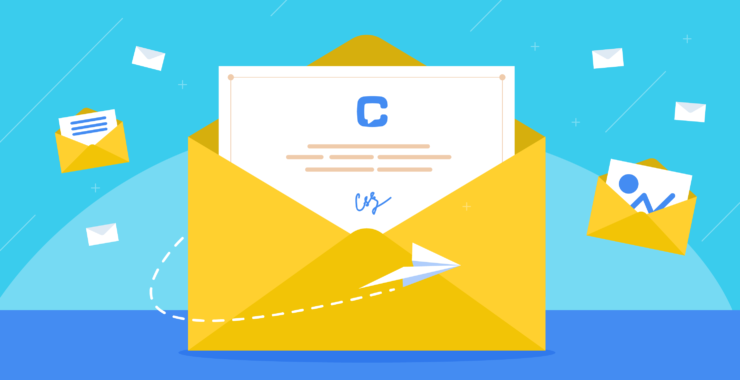Writing emails is a form of professional communication art in itself. To be heard and pay attention to your email, you need to learn how to formulate your sentences correctly if you want to convey your message in the right way. Unlike other means of communication, email takes time, so you need to be laconic.
So, consider some attractive phrases that will allow you to write emails like a boss. And don’t be afraid, because writing an email like a boss isn’t as difficult as writing a chatbot script. But first, here are some professional tips on how to write emails like a boss in a way that will capture the reader’s attention right away.
10 Professional tips to email like a boss
1. Be laconic
Get straight to the point in your email. It would help if you draw the readers’ attention to what you want to convey—no fluff or spam.
You need to write a text that is quick and easy to understand but do not forget about grammar. If you need assistance writing professional texts, you can go to one-of-a-kind websites that offer writing services. This will help you, over time, to write emails clearly and concisely.
2. Specify the subject of the emails
Remember that a good subject is the first thing the reader will see. Ensure that the subject line is clear and understandable and contains all the essential elements.
“Hope you had a great weekend/weekend/day.” It depends on what time or day of the week you address—the most common phrase in a business email.
“I am writing to you about…” You can put anything related to a previous conversation or meeting with the addressee here. You can also use this introduction to talk about upcoming events.
“Thank you for letting me know.” This subject shows that you acknowledge what the person has told you and express appreciation for it.
These are the most common examples when writing an email to your partner or client.
3. Send professional emails
If you are writing emails to employers and clients (not to your friends), keep the tone of your emails formal. Send your emails from a professional email address. Use your first name or initials and include a profile photo on your email account.
There are some problems with spam, for example, when your photos or emails end up where they shouldn’t. And, of course, there are the following reasons for this.
- There is no information about the sender, or the data needs to be more accurate. Check the sender’s email address. There are various online tools allowing you to check the email validity, so feel free to use one of them to make sure the email address exists – an email verification tool can come handy.
- Improper authentication. Some technologies will automatically prevent your emails from getting into spam filters.
- Use of spam triggers. Do not write all words in capital letters or insert many exclamation marks.
- Bad grammar. Check the text of your email.
With these methods to avoid spam, your emails will always be read.
When using an email signature, provide only the necessary information – links to your business websites, social media profiles, phone numbers, or a custom QR code containing all of the above.
When using an email signature also consider integrating more innovative elements like a how to create dynamic QR codes for easy access to your professional portfolio or company website, ensuring all necessary contact information is at your recipient’s fingertips.
4. Be confident like a boss
You should exude confidence and show a proactive attitude. Be assertive in your views, but respect your reader. In this way, you will attract attention.
Refrain from apologizing often enough. There are many circumstances in life, and everything can happen. But the question is how you formulate this discomfort while being responsible.
This formulation will show not only self-confidence but also speed up communication.
5. Hold back emotions, but in moderation
As mentioned above, an email from the boss should be business style. If you insert a lot of emojis and exclamation marks into the text, your email will be perceived as unprofessional, and you will be misunderstood. Greetings and farewells are an exception.
But! Being a nice and friendly person has never hurt anyone, especially since these are the rules of good manners. A compliment to the company or client and a good-day wish is a kind gesture for future collaboration and a tool for team-building.
6. Individualize your emails
This is a must if you want to email like a boss!
Mass emailing is a good practice, but try to tailor your email to a specific audience or person for better effect. For example, you can individualize the subject line.
Basic email personalization includes tactics like using the recipient’s name in the subject line, while more advanced tactics can include changing the content of the email based on the recipient’s gender, location, or other information you know about them.
For example, if we talk about the subject line. After the “from” title, the subject line is the second most visible element in an email inbox. On most devices, the subject line has darker, heavier text in an attempt to make it stand out from the rest of the email.
Converse does this well in their email campaigns by adding the subscriber’s name to the subject line to help the campaign stand out in the inbox and get people to open it.
It looks like this:
From: Converse.
Subject: Richard, get 10% off the Richard Benson All Good today!
7. Make a schedule of mass communications
Do not rush with the mailing! Try to send emails to a small list of people first; over time, you will increase the mailing volume. Focus on the indicators and start growing the list of receivers.
Use technology for effective time management in various applications and tools on dedicated websites.
8. Be cool-headed
Don’t let emotions ruin your business relationship. Write emails with feedback in mind.
Arguing with clients or colleagues via email will make you look irrational and furious.
The boss always keeps a cool head when all of his colleagues are already tearing up and swearing.
9. Proofread before sending
Make sure your grammar is on point, there are no mistakes, the punctuation is in place, etc. There are multiple writing services engaged in proofreading at a professional level, and, if desired, no one stops you from reaching out to ask for consultation. Grammar mistakes and inattention to detail turn off potential customers and are a signal to colleagues. Be sure to proofread your emails before you send them.
10. Get your feedback and a response
After sending an email, you should wait for a reply. The first email you send should attract as much attention as possible. You can check to see if there is a response by monitoring the situation on a regular basis. If no one responds, it is a bad sign.
So, we have looked at ten tips on how to write an email like a boss. Every business is looking for new ways to boost productivity, considering the numerous factors that affect it. But later, the chief and the organization will receive their compensation.
7 Examples of attractive phrases for the “email like a boss” strategy
So, here are some examples that will help you to write emails like a boss. Let’s look at them in a “write this way, not that way” style.
1. Conveying deadlines
Some people often underestimate deadlines and therefore ignore them. However, they will start working if you ask when they will complete the task.
Instead of: “The deadline for this is tomorrow, by about _____.”
Write: “When do you think you can do it?”
2. It took some time, but you will cope
Even the most punctual individuals can be delayed. Instead of apologizing, thank them for waiting.
Instead of: “Sorry for the delay.”
Write: “Thank you for your patience.”
3. I know what I am doing
“I think” is an uncertain and weak word. At times, confidence works well when writing emails like this one.
Instead of: “I think maybe we should __.”
Write: “It would be better if we __.”
4. Yes, please
“No problem” is a common cliché that no longer sounds sincere. This phrase is almost never used anymore.
Instead of “No problem!” or “No trouble!”
Write: “Always a pleasure to help!”
5. My schedule also matters
This formulation is a soft way to ask about it when you are sure the time is right.
Instead of: “What works best for you?”
Write: “Could you do __:__?”
6. I made a little mistake
Learn from your mistakes! Instead of constantly apologizing, make it more positive.
Instead of: “Oh, sorry! It’s my mistake. I didn’t see that at all.”
Write: “Oh, thanks! Now, the file’s up-to-date.
7. I have an appointment
It is better to tell you about your schedule in advance. This way, everyone will be aware.
Instead of: “Can I leave early?”
Write: “I will need to leave at __ at __:__.”
Remember, measure twice, and cut once. If you behave like a boss—wisely and confidently—everyone will be grateful to you.
Learn to email like a boss
Want to email like your boss? You’ll need confidence, clarity, and a touch of professionalism that allows you to communicate effectively in any business situation. Crafting great emails isn’t just about writing well—it’s about writing with purpose and impact. The best communicators know how to be clear without being overbearing, concise without losing detail, and professional without sounding robotic.
To email like a boss, you need to develop some key qualities and skills:
1. Confidence in your communication
Confidence is the backbone of any successful email. This doesn’t mean being arrogant, but speaking with confidence. Know what you want to say and get to the point quickly. A confident tone ensures that your message isn’t lost in ambiguity and shows that you respect the recipient’s time.
2. Clarity over complexity
Clear communication is at the heart of a good email. Avoid jargon and lengthy explanations. Make your message easy to understand by breaking down complex ideas into digestible chunks. Remember, simplicity is powerful.
3. Professional, not robotic
Business language doesn’t mean a lack of warmth. Keep your tone professional, but make sure it’s also approachable. Being too formal can make your emails feel stiff while being too casual can make you seem unprofessional. Aim for a happy medium that reflects both your expertise and your personality.
And when you’re ready to take it to the next level, technology can be your best ally. With the right tools, you can ensure that your emails are polished, error-free, and delivered at the right time for maximum impact.
Boost your email writing with the power of technology
Leverage the power of technology to take your email communication to the next level. Here’s how various tools can help you:
- Grammar and Readability Checkers: Your emails must be error-free. Tools can help catch spelling and grammar mistakes while improving the overall readability of your messages. These checks help your emails look polished and ensure your language is clear and professional.
- Optimize the timing of email delivery: As well as writing well, you need to send your emails at the right time. Consider optimizing delivery times based on when your audience is most likely to engage. By scheduling emails for peak times, you can increase the chances of your message being seen and acted upon.
- Use pre-designed templates: For repetitive communications, templates can save time. Ready-to-use templates for common types of emails – such as follow-ups, meeting reminders, or thank-you notes – can ensure that your messages are both efficient and consistent, helping you to maintain a professional image across the board.
Finding the right tone
Striking the right tone in an email can make the difference between getting a response and being ignored. Whether you’re writing to your boss, a colleague, or a client, knowing when to be formal and when to be friendly is key to successful communication.
The balance between formality and friendliness depends on the context and the recipient. Here’s how to get it right:
1. When to be formal
Formal emails are a must when communicating with people you don’t know well or when the situation requires professionalism. A formal tone ensures that you show respect and maintain a level of professionalism. For example, if you’re emailing a potential client, a new colleague or someone in a higher position than you, it’s important to keep your language polished and polite.
- How to do it:
Use formal greetings and titles, and address the recipient correctly and respectfully. Close with polite phrases that maintain a professional edge. - Why it works:
Formal emails convey respect and set the tone for a professional relationship. They leave no room for misinterpretation and ensure that your message is taken seriously.
2. When to be friendly
A friendly tone can help you build rapport and strengthen relationships, especially with colleagues, peers or clients with whom you’ve already established trust. Friendly emails are more approachable and can make communication feel warmer, which can be beneficial in maintaining strong working relationships.
- How to do it:
Start with a casual greeting and use a conversational tone throughout. Keep the language polite but less rigid, and use friendly phrases that invite further interaction. - Why it works:
A friendly tone makes the email feel less transactional and more personal, which encourages a positive response. It helps maintain a comfortable working environment and shows that you’re approachable.
Getting the right balance
Knowing when to switch between formal and friendly depends on your familiarity with the recipient and the context. If you’re emailing someone for the first time, it’s usually better to start off formal. As your relationship with the recipient grows and you communicate more frequently, you can gradually adopt a friendlier tone.
For example, a first email to a client should be more formal, but subsequent emails can be more relaxed once you’ve established a rapport. On the other hand, if the subject is serious or sensitive, it’s always better to err on the side of formality.
Mastering the tone of your emails shows emotional intelligence and an understanding of your audience. The better you can adapt to the needs of the situation, the more effective and boss-like your email communication will be.
Mastering Email Communication Like a Boss
Mastering email communication is all about striking the right balance – clear, confident, and professional with just a touch of personality. Whether you’re emailing a colleague, a client, or your boss, the goal is to be efficient and respectful, while still sounding like a human being, not a robot! By following these tips, you’ll be able to write emails that get straight to the point, avoid confusion, and come across as someone who knows their stuff.
And remember, practice makes perfect! The more you fine-tune your emailing style, the easier it will be to strike the perfect tone – whether formal or friendly. Plus, using helpful tools along the way can ensure your emails are polished and professional without the stress of nitpicking every little detail.
So the next time you sit down to write an email, channel your inner boss. Keep it clear, concise, and confident – and soon you’ll be emailing like a pro!








